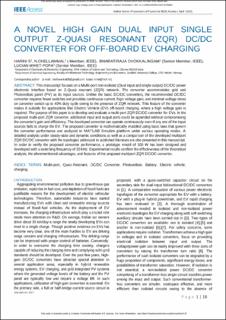| dc.contributor.author | Harini, S. | |
| dc.contributor.author | Chellammal, N. | |
| dc.contributor.author | Chokkalingam, Bharatiraja | |
| dc.contributor.author | Mihet-Popa, Lucian | |
| dc.date.accessioned | 2022-09-19T13:59:26Z | |
| dc.date.available | 2022-09-19T13:59:26Z | |
| dc.date.created | 2022-08-02T10:52:12Z | |
| dc.date.issued | 2022 | |
| dc.identifier.citation | IEEE Access. 2022, 10, 83350 - 83367. | en_US |
| dc.identifier.issn | 2169-3536 | |
| dc.identifier.uri | https://hdl.handle.net/11250/3018978 | |
| dc.description.abstract | This manuscript focuses on a Multi-port non-isolated (Dual input and single output) DC/DC power electronic interface based on Z-Quasi resonant (ZQR) network. The converter accommodates grid and Photovoltaic panel (PV) as its input sources. Unlike the basic DC/DC converters, the recommended DC/DC converter requires fewer switches and provides continuous current, high voltage gain, and minimal voltage stress on converter switch up to 40% duty cycle owing to the presence of ZQR network. This feature of the converter makes it suitable for applications like Electric Vehicle (EV) off-board charging, where a high voltage gain is required. The purpose of this paper is to develop and evaluate a multi-port ZQR DC/DC converter for EVs. In the proposed multi-port ZQR converter, additional input and output ports could be appended without compromising the converter's gain and efficiency. The developed converter can operate continuously even if any one of the input sources fails to charge the EV. The proposed converter is mathematically modeled using basic laws that govern the converter performance and analyzed in MATLAB Simulink platform under various operating modes. A detailed analysis under steady-state and dynamic conditions as well as a comparison of the developed multiport ZQR DC/DC converter with the topologies addressed in published literature are also presented in this manuscript. In order to verify the proposed converter performance, a prototype model of 300 W has been designed and developed with a switching frequency of 20 kHz. Experimental results confirm the effectiveness of the theoretical analysis, the aforementioned advantages, and features of the proposed multiport ZQR DC/DC converter. | en_US |
| dc.language.iso | eng | en_US |
| dc.publisher | IEEE | en_US |
| dc.rights | Navngivelse 4.0 Internasjonal | * |
| dc.rights.uri | http://creativecommons.org/licenses/by/4.0/deed.no | * |
| dc.subject | multi-port | en_US |
| dc.subject | quasi-resonant | en_US |
| dc.subject | DC/DC converter | en_US |
| dc.subject | photovoltaic | en_US |
| dc.subject | battery | en_US |
| dc.subject | electric vehicle | en_US |
| dc.subject | charging | en_US |
| dc.title | A Novel High Gain Dual Input Single Output Z-Quasi Resonant (ZQR) DC/DC Converter for Off-Board EV Charging | en_US |
| dc.type | Peer reviewed | en_US |
| dc.type | Journal article | en_US |
| dc.description.version | publishedVersion | en_US |
| dc.subject.nsi | VDP::Teknologi: 500 | en_US |
| dc.source.pagenumber | 83350 - 83367 | en_US |
| dc.source.volume | 10 | en_US |
| dc.source.journal | IEEE Access | en_US |
| dc.identifier.doi | 10.1109/ACCESS.2022.3195936 | |
| dc.identifier.cristin | 2040581 | |
| cristin.ispublished | true | |
| cristin.fulltext | original | |
| cristin.qualitycode | 1 | |

